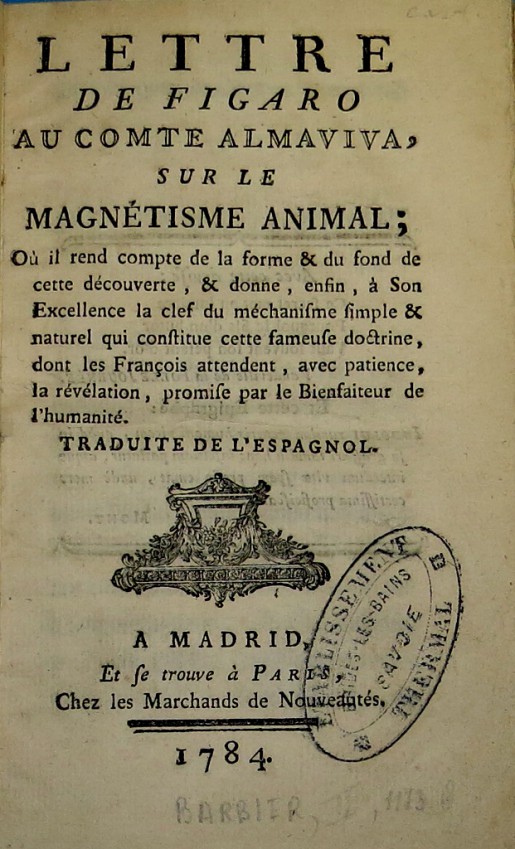Animal magnetism is a healing system based on the belief that the existence of a universal magnetic fluid is central to the restoration and maintenance of health. The basic principles were articulated in Franz Anton Mesmer’s Mémoire sur la découverte du magnétisme animal, published in 1779. Mesmer was not successful in gaining support from the medical establishment in Vienna, so he relocated to Paris where he operated two treatment clinics.
The medical faculty of Paris was alarmed at the popularity of Mesmer’s clinics. Two royal commissions were formed to investigate animal magnetism. Both produced unfavorable reports. These statements initiated a wave of tracts supporting or objecting to their conclusions. Some of those works participating in the heated discussion are currently on display in Falk Library. Among these books, there is an interesting and rare pamphlet, Lettre de Figaro au comte Almaviva sur le magnétisme animal (1784). The Spanish references from the title (Figaro’s letter to Count Almaviva…) are fictional. It was written by a physician from Lyon—Brack, who was known only by his last name. His Lettre was very popular and was issued several times that year.
 The tract was written to serve in the campaign against animal magnetism. It was focused on a popular topic, short lived, and tossed away when the interest in animal magnetism faded. Consequently, tracts are quite scarce. There are several copies of the second edition in the United States and France, but finding a first edition copy is very rare. Two identified copies, one in the Bibliothèque nationale de France and one in the University of Oklahoma are of the same variety. A digital version is available from the Bibliothèque nationale de France. The copy in Falk Library is different. The text is the same, but the publisher was forced to make changes to the layout of the title page and the remaining text to fit the new duodecimo format. The final bound copy is only 10.5 x 16.5 cm and the main text occupied 57 pages (more than 38 pages in the BnF copy). The paper has clear watermarks easy to examine with a bare eye. Falk Library’s copy is also identified with a stamp of the previous owner. This unique version is currently on display in the Falk Library lobby.
The tract was written to serve in the campaign against animal magnetism. It was focused on a popular topic, short lived, and tossed away when the interest in animal magnetism faded. Consequently, tracts are quite scarce. There are several copies of the second edition in the United States and France, but finding a first edition copy is very rare. Two identified copies, one in the Bibliothèque nationale de France and one in the University of Oklahoma are of the same variety. A digital version is available from the Bibliothèque nationale de France. The copy in Falk Library is different. The text is the same, but the publisher was forced to make changes to the layout of the title page and the remaining text to fit the new duodecimo format. The final bound copy is only 10.5 x 16.5 cm and the main text occupied 57 pages (more than 38 pages in the BnF copy). The paper has clear watermarks easy to examine with a bare eye. Falk Library’s copy is also identified with a stamp of the previous owner. This unique version is currently on display in the Falk Library lobby.
~ Gosia Fort